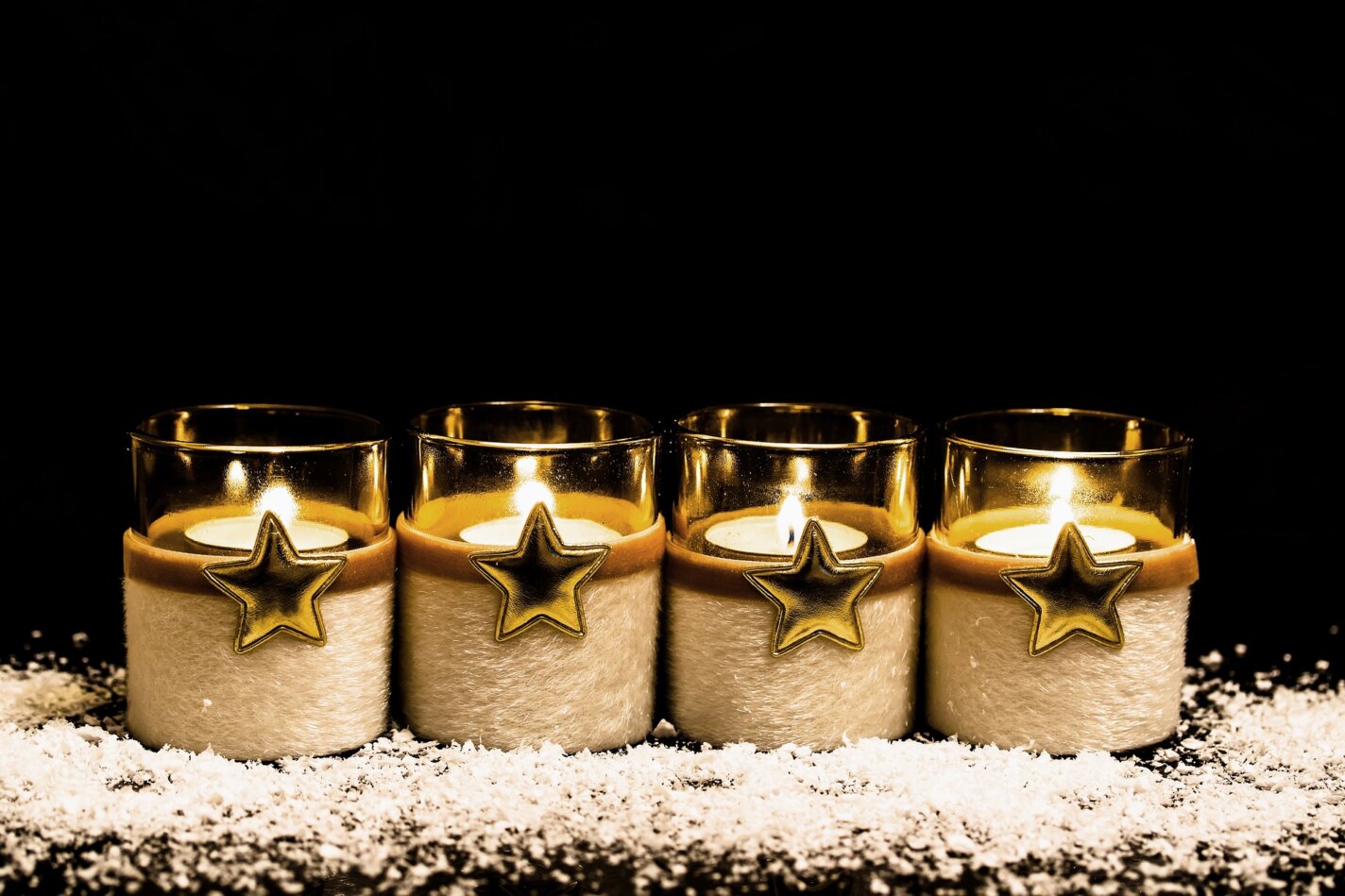December 18, 2022
December - a month of celebrations
Hej, hej!
Let’s talk about the December celebrations!
Christmas is originally a religious Christian celebration to celebrate the birth of Jesus. In Sweden, over half of the population identify with the Church of Sweden (part of the Lutheran tradition in Protestantism) after it overthrew Catholicism in the XVI century. Therefore, Christmas is a celebration with a longstanding presence in Swedish culture. Over the years Sweden, however, has become less religious and even if the religious background of the celebration is still of importance, the Swedish Christmas is more of a traditional cultural celebration nowadays. It comes with multiple customs that I will present to you in this blog. So let’s buckle up because this will be a long list but it has been approved by a Swede 😉
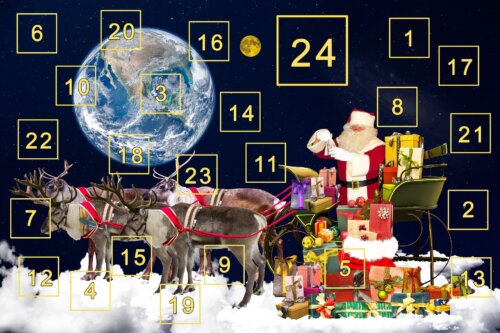
Preparation for Christmas starts around 4 weeks beforehand and this time is called Advent. Precisely, it is 4 Sundays before Christmas when Swedish homes are decorated with Adventsstjärna (a star) in windows and four candles (cover photo) are prepared which mark the Sundays of Advent – a new candle is lit each Sunday. As we know, in December, we have very few hours of daylight. The tradition of lighting a candle for each Sunday is, therefore, both figuratively and literally significant for the light it brings. Additionally, Swedes have a Julkalender (picture above) which is a TV show that airs every day between the 1-24 of December. You can also buy a printed version of it and you are allowed to open one box from the calendar every day. This is also in a way a countdown to Christmas. Do you have something similar in your country?
Julskyltning is the traditional Christmas decoration in the shops often displayed in the window. This has been a tradition in Sweden since the 19th century and has always been a popular happening to mark the start of December. From the beginning, the Julskyltning didn’t start until 2 weeks before Christmas Eve (24th December) but nowadays the decorations are already displayed at the end of November.
Christmas markets are a popular place to visit in December (or November) to buy decorations, food and gifts. Some of the most popular Christmas markets in Sweden are the Liseberg in Gothenburg (right) and Skansen in Stockholm. This year, I had a chance to visit the Christmas market in Gothenburg and it was marvellous 🙂 In Linköping, we also have a Christmas market but much smaller (below is a decoration on a regular day). Regardless of the place, the atmosphere is always great!
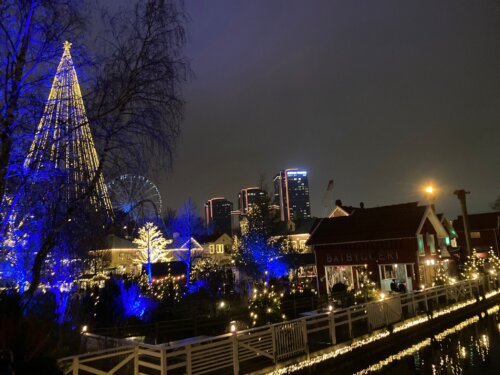
In my opinion, Swedish Christmas decorations are simple but very pretty. Especially, plants are an important part of home decorations. Along with the lights – Adventsstjärna or ljusstaka – they’ve been used to brighten up the building during long, dark winter. Popular Christmas plants include poinsettias (in the picture), tulips and begonias. However, hyacinths are the most favourite Swedish Christmas flower although they’re primarily a spring flower! It’s very common to smell the pungent fragrance of hyacinths in Swedish houses.

There is one more intense scent you can smell around Christmas namely, oranges. They could be sliced and put on the Christmas tree or prepared with clove. Of course, we have Christmas trees as decorations. But there are also two more types of decorations. It’s straw and wood elements. A little Santa Claus that you can find almost everywhere is called Jultomte. I personally find it peculiar but what do you think?
Moreover, when December comes cities across Sweden get a whole new look with lights and decorations! In Norrköping, you can enjoy spectacular light and art installations (but they last only until the 8th of January 2023). Also, you can admire a beautiful Christmas tree (below) right in the city centre of Linköping – Stora Torget.
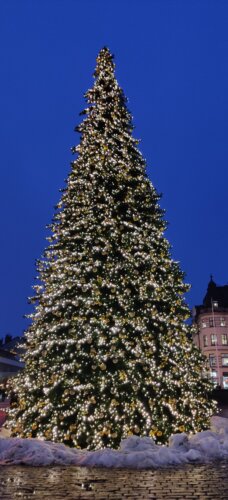 Julmust means Christmas juice and it’s a typical Swedish Christmas soft drink. The taste of Julmust might slightly differ between retailers but overall, Julmust is sweeter than most sodas with hints of cola and root beer flavour which makes it rather distinct. Julmust is sold ONLY around the Christmas season and interestingly, it outsells coca-cola in Sweden (sometimes even by 50%). It definitely makes it a special and essential drink during Christmas in Sweden. Have you tried it already? Another drinks strongly associated with Swedish Christmas is glögg. It’s a spiced mulled wine known in Sweden since the XVI century. There are multiple recipes but glögg originally consists of 1) an alcohol base (wine, schnapps, cognac); 2) spices (cinnamon, cardamom, cloves, ginger); 3) sugar or honey. Additionally, raisins and blanched almonds are added.
Julmust means Christmas juice and it’s a typical Swedish Christmas soft drink. The taste of Julmust might slightly differ between retailers but overall, Julmust is sweeter than most sodas with hints of cola and root beer flavour which makes it rather distinct. Julmust is sold ONLY around the Christmas season and interestingly, it outsells coca-cola in Sweden (sometimes even by 50%). It definitely makes it a special and essential drink during Christmas in Sweden. Have you tried it already? Another drinks strongly associated with Swedish Christmas is glögg. It’s a spiced mulled wine known in Sweden since the XVI century. There are multiple recipes but glögg originally consists of 1) an alcohol base (wine, schnapps, cognac); 2) spices (cinnamon, cardamom, cloves, ginger); 3) sugar or honey. Additionally, raisins and blanched almonds are added.
No Swedish Christmas is complete without the traditional saffron bun (lussekatt) – they’re also my favourite Swedish baked good. It’s a sweet bun with saffron. Various cultural and historical layers are intertwined with each other regarding the origin of these delicious saffron buns. One of them says that its bright yellow colour was supposed to scare the devil away. Primarily, it was associated with the winter solstice but after the introduction of the Georgian calendar, that day has been moved to December 13th. Later, this tradition was associated with the celebration of Saint Lucia. Additionally, we have pepparkakor and gingerbread houses that are commonly baked during this time of the year. You can also notice that shops are full of Juleskum (sweets) and Paradis or Aladdin chocolates. You can only buy those around Christmas!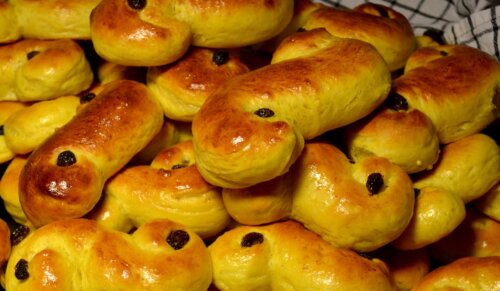 Now, we’re coming to the very important part of Christmas – food 😀 In Sweden, Julbord (Christmas table) is very popular. It’s a buffer of various dishes that you eat during Christmas (but to be honest you also eat these for other big celebrations 😉 ) Some dishes vary between counties but generally, it consists of 4 courses. Typically, it all begins with a glass of glogg and then the food frenzy starts with seafood. It usually resolves around lax (salmon) and sill (herring). You can never have enough herring on Julbord thus, there are many variations. In the first course, you can also find eggs in different forms.
Now, we’re coming to the very important part of Christmas – food 😀 In Sweden, Julbord (Christmas table) is very popular. It’s a buffer of various dishes that you eat during Christmas (but to be honest you also eat these for other big celebrations 😉 ) Some dishes vary between counties but generally, it consists of 4 courses. Typically, it all begins with a glass of glogg and then the food frenzy starts with seafood. It usually resolves around lax (salmon) and sill (herring). You can never have enough herring on Julbord thus, there are many variations. In the first course, you can also find eggs in different forms.
Let’s move on to the 2nd course – cold meats. The julskinka (Christmas ham) is essential and it’s typically the most important part of Julbord. Additionally, you can also find smoked moose or reindeer. An appropriate company to meat is julost (Christmas cheese). We also have rödbetssallad (beetroot salad) and perhaps other salads.
After cold meats, we have warm dishes. We all have heard about meatballs so it’s not surprising that they’re one of the quintessential Christmas dishes. They could be paired with Janssons frestelse (Swedish casserole made of potatoes). Here we can also find various sausages or kåldolmar (stuffed cabbage rolls with lingonberry jam).
And now it’s the time for the last bit – dessert. It could be, for example, saffron cake or chocolate cake – this really depends. However, there is one dessert worth describing. Risgrynsgröt (or tomtegröt) is a Swedish version of rice pudding (it’s kind of like a porridge). A popular tradition is hiding an almond in the batch of porridge and a person who finds it will be lucky. Swedish families leave a bowl with this porridge in the garden. This tradition goes back in time… and it all started with elves. People believed that elves help around the house and the barn. In return, people must have taken care of them by e.g. treating them with tomtegröt on Christmas Eve.
And now, when we have gone through all this… 24th of December has arrived. The last most important thing to do at 15.00 is to watch Donald Duck! It’s been a tradition since the 1960s and even though it’s the same show every year many Swedes both children and adults gather together to watch it. If you’re interested it’s also broadcasted online at svtplay.se
Do you like Swedish traditions? Which one do you find the most interesting? Do you have similar things in your country? Share your thoughts in the comments!
For those celebrating, have a lovely Christmas!
And everybody, have a great rest of December!
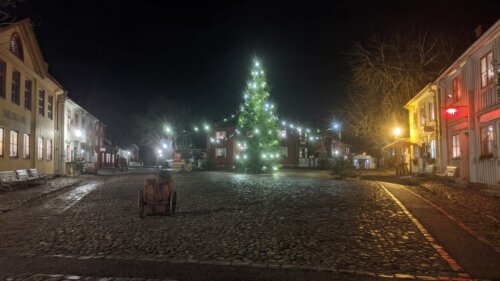
/Alexandra, Experimental and Medical Biosciences
________________________________________________________________________________________________
Why don’t continue the conversation with us?
Start with checking out:
Our programmes, the application process, webinars, and our Instagram and Facebook account.
Still left wanting more?Book an appointment with our recruitment coordinator at infocenter@liu.se.
